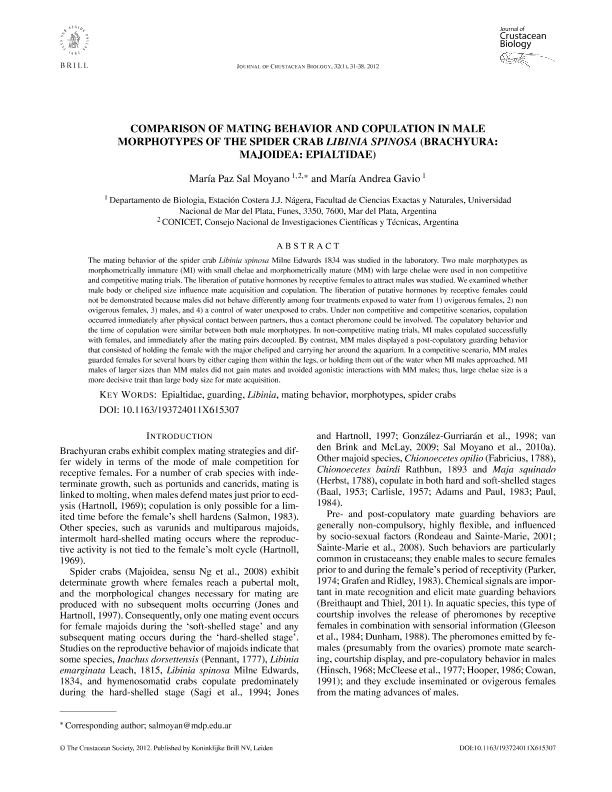Mostrar el registro sencillo del ítem
dc.contributor.author
Sal Moyano, María Paz

dc.contributor.author
Gavio, Maria Andrea

dc.date.available
2021-05-10T16:08:08Z
dc.date.issued
2012-02
dc.identifier.citation
Sal Moyano, María Paz; Gavio, Maria Andrea; Comparison of mating behavior and copulation in male morphotypes of the spider crab Libinia spinosa (Brachyura: Majoidea: Epialtidae); Crustacean Society; Journal of Crustacean Biology; 32; 1; 2-2012; 31-38
dc.identifier.issn
0278-0372
dc.identifier.uri
http://hdl.handle.net/11336/131760
dc.description.abstract
The mating behavior of the spider crab Libinia spinosa Milne Edwards 1834 was studied in the laboratory. Two male morphotypes as morphometrically immature (MI) with small chelae and morphometrically mature (MM) with large chelae were used in non competitive and competitive mating trials. The liberation of putative hormones by receptive females to attract males was studied. We examined whether male body or cheliped size influence mate acquisition and copulation. The liberation of putative hormones by receptive females could not be demonstrated because males did not behave differently among four treatments exposed to water from 1) ovigerous females, 2) non ovigerous females, 3) males, and 4) a control of water unexposed to crabs. Under non competitive and competitive scenarios, copulation occurred immediately after physical contact between partners, thus a contact pheromone could be involved. The copulatory behavior and the time of copulation were similar between both male morphotypes. In non-competitive mating trials, MI males copulated successfully with females, and immediately after the mating pairs decoupled. By contrast, MM males displayed a post-copulatory guarding behavior that consisted of holding the female with the major cheliped and carrying her around the aquarium. In a competitive scenario, MM males guarded females for several hours by either caging them within the legs, or holding them out of the water when MI males approached. MI males of larger sizes than MM males did not gain mates and avoided agonistic interactions with MM males; thus, large chelae size is a more decisive trait than large body size for mate acquisition.
dc.format
application/pdf
dc.language.iso
eng
dc.publisher
Crustacean Society

dc.rights
info:eu-repo/semantics/openAccess
dc.rights.uri
https://creativecommons.org/licenses/by-nc-sa/2.5/ar/
dc.subject
EPIALTIDAE
dc.subject
GUARDING
dc.subject
LIBINIA
dc.subject
MATING BEHAVIOR
dc.subject
MORPHOTYPES
dc.subject
SPIDER CRABS
dc.subject.classification
Biología Reproductiva

dc.subject.classification
Ciencias Biológicas

dc.subject.classification
CIENCIAS NATURALES Y EXACTAS

dc.title
Comparison of mating behavior and copulation in male morphotypes of the spider crab Libinia spinosa (Brachyura: Majoidea: Epialtidae)
dc.type
info:eu-repo/semantics/article
dc.type
info:ar-repo/semantics/artículo
dc.type
info:eu-repo/semantics/publishedVersion
dc.date.updated
2021-04-23T19:23:10Z
dc.journal.volume
32
dc.journal.number
1
dc.journal.pagination
31-38
dc.journal.pais
Estados Unidos

dc.description.fil
Fil: Sal Moyano, María Paz. Consejo Nacional de Investigaciones Científicas y Técnicas. Centro Científico Tecnológico Conicet - Mar del Plata. Instituto de Investigaciones Marinas y Costeras. Universidad Nacional de Mar del Plata. Facultad de Ciencias Exactas y Naturales. Instituto de Investigaciones Marinas y Costeras; Argentina
dc.description.fil
Fil: Gavio, Maria Andrea. Universidad Nacional de Mar del Plata. Facultad de Ciencias Exactas y Naturales. Departamento de Biología; Argentina
dc.journal.title
Journal of Crustacean Biology

dc.relation.alternativeid
info:eu-repo/semantics/altIdentifier/url/https://academic.oup.com/jcb/article/32/1/31/2419338
dc.relation.alternativeid
info:eu-repo/semantics/altIdentifier/doi/https://doi.org/10.1163/193724011X615307
Archivos asociados
